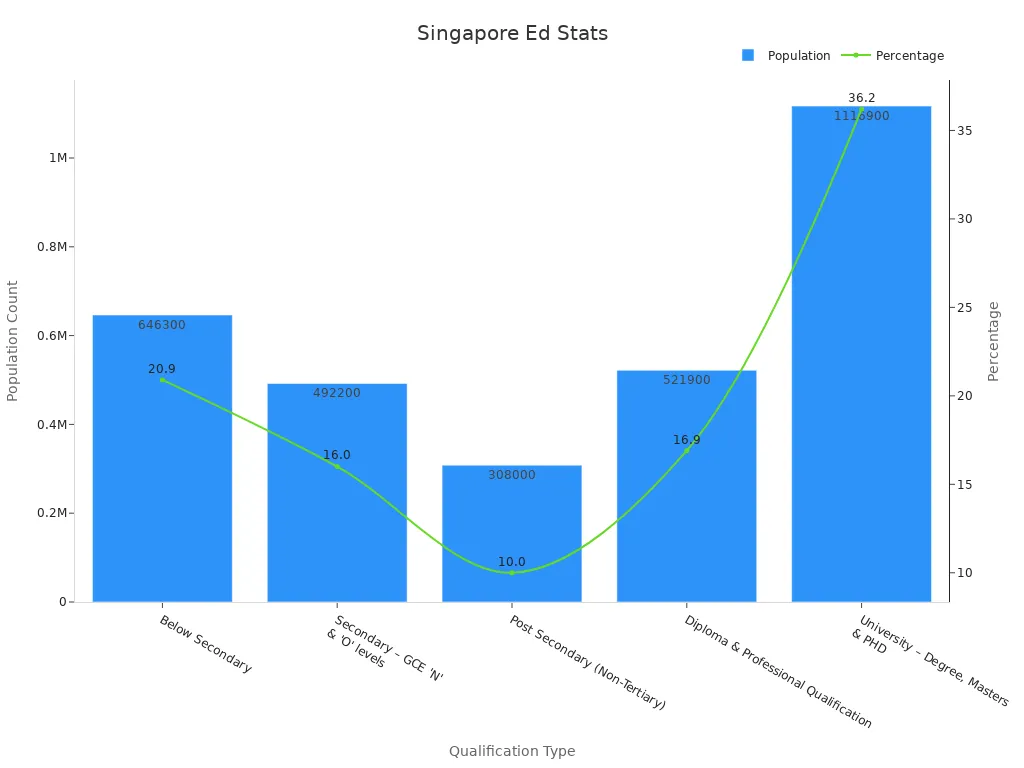
Understanding the cost of education in Singapore is crucial for parents. 💰 Public education offers affordability, but fees vary across stages. For instance, primary school tuition for Singaporean students costs about SGD 25 monthly, while secondary school fees for permanent residents (PRs) can reach SGD 320. Specialized schools like SOTA charge up to SGD 400 per month. These figures highlight the importance of planning. Knowing the public education cost helps you prepare for expenses like tuition, materials, and transportation, ensuring your child’s educational journey remains smooth and stress-free.
Breakdown of Singapore Public Education Cost by Stage
Preschool Education
Monthly school fees for public preschools
Preschool education in Singapore offers a range of options, with costs varying significantly between government and private childcare centers. Government childcare centers typically adjust fees based on the child’s age and the specific branch.
Private childcare centers, however, charge between $1,000 and over $3,000 monthly. These fees reflect the quality of care, curriculum, and facilities provided.
Additional costs such as uniforms, materials, and excursions
Beyond monthly fees, preschools often require additional payments for uniforms, learning materials, and excursions. Uniforms can cost around $50 to $100 per set, while materials like books and stationery may add another $100 to $200 annually.
Excursions, which enhance learning experiences, usually cost $20 to $50 per trip. These supplementary expenses should be factored into your budget when planning for preschool education.
Primary School
Tuition fees for Singapore citizens, PRs, and foreigners
Primary education in Singapore is heavily subsidized for citizens, making it free of tuition fees. However, permanent residents (PRs) and international students incur monthly school fees. PRs pay $205, while international students from ASEAN countries pay $465.
Non-ASEAN international students face higher fees of $775 monthly. The Ministry of Education ensures affordability for citizens while maintaining a structured fee system for others.
|
Citizenship |
Monthly School Fees |
|---|---|
|
Singapore Citizen |
Free |
|
PR |
S$205 |
|
International (ASEAN) |
S$465 |
|
International |
S$775 |
Miscellaneous fees and other related expenses
Although tuition is free for citizens, miscellaneous fees apply. These range from $6 to $13 monthly, covering essential school services and activities. Over six years, total costs for citizens range from $468 to $936.
For PRs, the total cost rises to $16,560 to $19,296. Additional expenses, such as uniforms, books, and transportation, can add $500 to $1,000 annually.
Secondary School
School fees for government and independent schools
Secondary school fees vary depending on the type of school. Government schools charge $25 to $43 monthly for citizens, while PRs pay $400 to $418. International students pay $800 to $1,488. Independent schools, offering specialized programs, charge significantly higher fees, ranging from $300 to $2,500 monthly.
|
School Type |
Singapore Citizen Fees (Monthly) |
PR Fees (Monthly) |
International Fees (Monthly) |
|---|---|---|---|
|
Government School |
S$25 to S$43 |
S$400 to S$418 |
S$800 to S$818 |
|
Independent School |
S$300 to S$600 |
S$600 to S$1,000 |
S$1,000 to S$2,500 |
Costs for co-curricular activities (CCAs) and school programs
Co-curricular activities (CCAs) and enrichment programs form an integral part of secondary education. These activities often require additional funding. Research shows that government expenditure per secondary school student increased from $5,700 in 2004 to $14,744 in 2017. This funding supports CCAs and programs like the Edusave and Opportunity Fund, which help less affluent families. However, parents may still need to budget $100 to $300 annually for uniforms, equipment, and participation fees.
Post-Secondary Education
Tuition fees for junior colleges, polytechnics, and Institutes of Technical Education (ITE)
Post-secondary education in Singapore offers diverse pathways, each with varying tuition fees. Junior colleges are the most affordable option for Singapore citizens, with monthly fees of just SGD 6. However, permanent residents (PRs) and international students pay significantly more, at SGD 460 and SGD 1,040 per month, respectively. Polytechnics and Institutes of Technical Education (ITE) cater to students seeking practical skills and technical knowledge.
Polytechnic tuition fees average SGD 2,900 annually for citizens, while PRs and international students pay SGD 6,000 and SGD 11,000, respectively. ITE fees are even lower for citizens, ranging from SGD 446 to SGD 626 annually, depending on the program.
PRs and international students face higher costs, with fees reaching up to SGD 7,844 and SGD 20,482, respectively.
|
Institution Type |
Citizenship |
Tuition Fees (Annual) |
|---|---|---|
|
Junior College |
Singapore Citizen |
SGD 6 (monthly) |
|
|
PR |
SGD 460 (monthly) |
|
|
International |
SGD 1,040 (monthly) |
|
Polytechnic |
Singapore Citizen |
SGD 2,900 |
|
|
PR |
SGD 6,000 |
|
|
International |
SGD 11,000 |
|
Institute of Technical Education (ITE) |
Singapore Citizen |
SGD 446 – 626 |
|
|
PR |
SGD 5,634 – 7,844 |
|
|
International |
SGD 15,572 – 20,482 |
Additional costs such as materials and transportation
Beyond tuition, you should consider other education costs like materials and transportation. Textbooks, stationery, and specialized equipment can add SGD 200 to SGD 500 annually. Transportation costs vary based on the distance between home and school, averaging SGD 100 to SGD 150 monthly. These expenses can significantly impact your budget, especially for students attending institutions far from home.
Tertiary Education
Tuition fees for local universities
Singapore’s local universities provide high-quality education at competitive rates. Tuition fees for Singapore citizens range from SGD 8,200 to SGD 9,600 annually for most undergraduate programs. PRs and international students pay higher fees, which can go up to SGD 38,200 annually, depending on the course and university.
For example, the National University of Singapore (NUS) and Nanyang Technological University (NTU) charge SGD 8,200 to SGD 9,600 annually for citizens, while specialized institutions like the Singapore University of Technology and Design (SUTD) charge SGD 13,300.
|
University |
Tuition Fees (Annual) |
|---|---|
|
National University of Singapore (NUS) |
SGD 8,200 – 9,600 |
|
Nanyang Technological University (NTU) |
SGD 8,200 – 9,400 |
|
Singapore Management University (SMU) |
SGD 11,450 |
|
Singapore University of Technology and Design (SUTD) |
SGD 13,300 |
|
Singapore University of Social Sciences (SUSS) |
Varies greatly |
|
Singapore Institute of Technology (SIT) |
Varies greatly |
Other expenses including accommodation, textbooks, and living costs
University students also face additional living expenses. On-campus accommodation costs SGD 1,600 to SGD 1,700 monthly, while off-campus options are slightly cheaper at SGD 800 to SGD 850. Food expenses average SGD 400 to SGD 450 monthly, and transportation adds another SGD 100 to SGD 150.
Entertainment, groceries, and clothing can increase monthly costs by SGD 280 to SGD 360. Overall, the annual cost of living for university students ranges from SGD 20,000 to SGD 25,000.
|
Expense Category |
Monthly Cost (SGD) |
|---|---|
|
Off-Campus Accommodation |
800 – 850 |
|
On-Campus Accommodation |
1,600 – 1,700 |
|
Transportation |
100 – 150 |
|
Food |
400 – 450 |
|
Entertainment |
60 – 80 |
|
Groceries |
70 – 80 |
|
Clothes |
150 – 200 |
|
Total (Off-Campus) |
1,700 – 1,800 |
|
Total (On-Campus) |
1,600 – 1,700 |
|
Annual Cost of Living |
20,000 – 25,000 |

Financial Assistance Schemes and Subsidies for Public Education
Government Subsidies
Subsidies for preschool education
Government subsidies play a significant role in reducing preschool costs for families in Singapore. For eligible Singaporean children, the government provides subsidies that lower monthly fees at public childcare centers. These subsidies depend on household income, with lower-income families receiving higher support.
For example, families earning less than SGD 3,000 monthly can receive up to SGD 740 in subsidies. This initiative ensures that preschool education remains accessible to all.
MOE subsidies for primary and secondary education
The Ministry of Education (MOE) offers extensive subsidies to make primary and secondary education affordable. Singaporean citizens benefit from free tuition at primary schools and significantly reduced school fees at secondary schools. Permanent residents (PRs) and international students pay higher fees, but subsidies still help offset costs. These subsidies ensure that no child is denied education due to financial constraints.
|
Aspect |
Description |
|---|---|
|
Subsidy Availability |
Extensive support is provided to make education affordable for Singaporean citizens and PRs. |
|
Cost Comparison |
Education costs for citizens are relatively low compared to other developed nations. |
|
Financial Support for Families |
Targeted financial support is aimed at low- to middle-income families to ensure equal opportunity. |
Financial Assistance Schemes (FAS)
Eligibility criteria and benefits
The MOE’s Financial Assistance Scheme (FAS) supports students from low-income families. To qualify, your household income must not exceed SGD 2,500, or your per capita income must be SGD 625 or less. Eligible students enjoy benefits such as full waivers of miscellaneous fees, partial subsidies for national examination fees, and reduced fees for independent schools. These measures ensure that financial barriers do not hinder your child’s education.
|
Criteria |
Value |
|---|---|
|
Gross household income |
SGD 2,500 |
|
Per capita income |
SGD 625 |
|
Benefits for eligible students |
Full waiver of fees, partial subsidies on exams and fees for Independent Schools |
Application process for FAS
Applying for the FAS is straightforward. You can obtain the application form from your child’s school or download it from the MOE website. Submit the completed form along with supporting documents, such as proof of income. Schools review applications and notify you of the outcome. This process ensures that financial support schemes reach those who need them most.
Other Support Programs
Edusave contributions and awards
The Edusave scheme provides financial support to all Singaporean children. Each child receives annual contributions to their Edusave account, which can be used for enrichment programs and school activities. Additionally, Edusave awards recognize students for academic excellence and good conduct. These initiatives reduce the cost of public education for Singaporean families while encouraging students to excel.
-
The Edusave Pupils Fund supports enrichment programs and resources, reducing educational costs.
-
Financial assistance targets lower-income families, ensuring equal opportunities.
-
Nine out of ten students from the lowest socio-economic quintile now pursue postsecondary education, a significant improvement over the past 15 years.
Community and charity-based assistance programs
Community organizations and charities also offer financial support schemes. Programs like ComLink+ assist families in breaking the poverty cycle, while the Mendaki scholarship provides full tuition coverage for eligible minority students. These initiatives complement government subsidies, ensuring comprehensive support for families in need.
|
Program |
Description |
Current Reach/Impact |
|---|---|---|
|
ComLink+ |
Aims to assist less privileged families with children to break the poverty cycle. |
Serves around 10,000 families, expanding to 3,000 more. |
|
Mendaki Scholarship |
Covers up to full tuition and fees for eligible minority populations. |
Demonstrates targeted support for those in need. |
Tips for Financial Planning and Saving for Education
Start Early
Importance of early financial planning
Starting financial planning early is essential for managing education costs effectively. Delaying this process often leads to reliance on education loans, which can create long-term financial burdens. By saving early, you can spread the financial load over several years, reducing the stress of large, sudden expenses.
Small, regular contributions to a savings plan can grow significantly over time due to compounding. This approach ensures you are better prepared for your child’s educational journey, whether it involves local schools or overseas institutions.
Setting up education savings accounts
Education savings accounts provide a structured way to save for your child’s future. Many parents in Singapore opt for long-term savings plans or education funds offered by banks and financial institutions. These accounts often come with benefits like higher interest rates or tax advantages.
For tertiary education, the CPF Education Scheme allows you to use your CPF savings to cover tuition fees, easing immediate financial pressure. Exploring these options early can help you align your savings with your child’s educational needs.
Budgeting for Education
Estimating the cost of education at each stage
Creating a realistic budget is crucial for managing education costs. Start by estimating the expenses for each stage of education, from preschool to tertiary levels. For instance, preschool fees can range from $1,000 to $3,000 monthly, while primary school fees for PRs and international students vary between $205 and $775 monthly.
Secondary school fees and additional costs for co-curricular activities should also be factored in. Understanding these figures helps you set achievable savings goals.
Allocating funds for miscellaneous expenses
Miscellaneous expenses, such as uniforms, books, and transportation, can add up quickly. Allocating a portion of your budget to these costs ensures you are not caught off guard. For example, annual transportation costs for secondary school students can average $1,200 to $1,800.
Utilizing financial assistance schemes like the MOE’s FAS can help cover some of these expenses, making education more affordable.
|
Expense Category |
Estimated Annual Cost (SGD) |
|---|---|
|
Uniforms and Books |
500 – 1,000 |
|
Transportation |
1,200 – 1,800 |
|
Co-Curricular Activities |
100 – 300 |
|
Miscellaneous Fees |
72 – 156 |
Exploring Additional Funding Options
Education loans and repayment plans
Education loans can be a viable option for covering higher education costs, but they should be approached cautiously. Banks and universities in Singapore offer various loan schemes with flexible repayment plans. For example, the CPF Education Scheme allows you to repay the loan interest-free until graduation. However, relying too heavily on loans can lead to financial strain, so it’s best to use them as a last resort.
Scholarships and bursaries
Scholarships and bursaries provide excellent opportunities to reduce education costs. Many schools and organizations in Singapore offer these based on academic performance, character, or financial need. For instance, Edusave scholarships reward students for excellence, while bursaries target those from lower-income families. These options not only ease financial burdens but also motivate students to excel academically.
|
Funding Option |
Eligibility Criteria |
Benefits |
|---|---|---|
|
Edusave Scholarships |
Academic excellence |
Covers part of the school fees |
|
MOE Financial Assistance |
Income-based |
Covers miscellaneous expenses |
|
Tuition Grant |
Singapore citizens in tertiary education |
Subsidizes tuition fees |
|
External Scholarships |
Varies by organization |
Full or partial tuition coverage |
The Singapore public education cost can be managed with thoughtful planning and strategic use of subsidies. Early financial planning helps you avoid excessive reliance on loans, reducing long-term financial stress. Various schemes, such as the MOE’s Financial Assistance Scheme and Edusave scholarships, provide targeted support for families across income levels.
Raising children in Singapore involves significant expenses, but effective planning ensures you can provide a smooth educational journey for your child. Start early, explore available resources, and take advantage of government support to reduce the financial burden.
